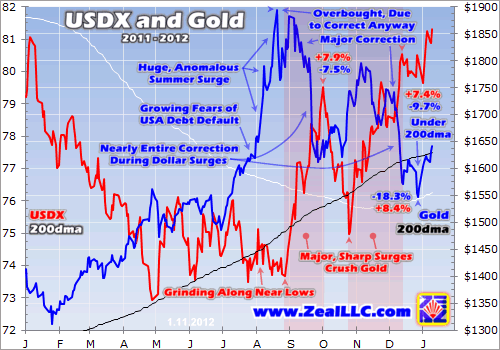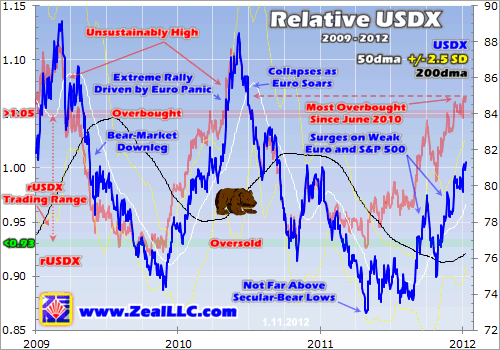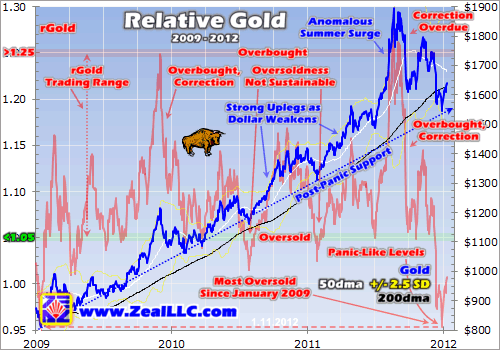|
|
|||||||
|
|
|
|
|
|
|
|
|
|
Dollar to Launch Gold Adam Hamilton January 13, 2012 2891 Words
Since rocketing to new all-time highs last summer, gold has weathered a major correction. While that selloff was healthy and necessary given the excessive optimism that catapulted gold to very-overbought levels, a strong US dollar accelerated goldís swoon. But with the dollar now as overbought and wildly popular as gold was in August, this currency itself is due for a major selloff that is likely to launch gold.
Thinking about the US dollar as a major gold driver brings back a lot of dusty memories for long-time gold investors and speculators. Gold bulls have three stages, and back in the early 2000s the entire gold story was the devaluing US dollar. Gold moved in lockstep opposition to this dominant currency. But by mid-2005, goldís secular bull was transitioning to its second stage where global investment demand took over as its primary driver.
Gold had finally escaped its restrictive dollar shackles, and started powering higher in all major currencies simultaneously. So where my earlier analyses focused on the dollarís overpowering impact on gold in the early 2000s, investment demand usurped it by the late 2000s. So regressing back to the old gold-moving-inverse-to-dollar paradigm this week feels pretty strange, no matter how temporary it proves.
But the charts donít lie, in the past half-year or so the US dollar has regained its throne as the dominant force moving gold prices. This first chart explores this rekindled relationship, looking at gold versus the US Dollar Index. The USDX is the widely-followed flagship benchmark for our currency, expressing the dollarís value relative to a euro-dominated basket of a half-dozen major foreign currencies.
Back in the first half of 2011, gold was powering higher in a nice bull-market upleg while the USDX was slumping. While the weaker dollar was certainly a factor in goldís advance, it was secondary at best. Gold was achieving a dazzling series of new record highs because global investment demand was growing faster than global mined supply. The dollar wasnít a huge influence, just as youíd expect deep in a secular gold bullís second stage.
By late April the USDX itself was getting very oversold, so a major bear-market rally was due in order to rebalance sentiment as I detailed at the time. Indeed the fear-laden dollar took off, but goldís reaction to this surge was muted and short-lived. Later in July, growing anxiety about Obamaís profligate overspending forcing the first-ever debt default in US history led to massive gold demand. But this was very anomalous for summer, which is usually a sentiment wasteland for the precious metals.
Note that while gold rocketed higher on USA-debt-default fears in July and August, the dollar wasnít falling. Instead it was drifting flatlined, goldís investment demand was totally independent of the dollarís fortunes. But goldís strength and popularity ballooned into a mini-mania, it had shot up too far too fast so a correction was due. I warned about gold being excessively overbought and due for a sharp imminent correction the trading day before it topped in August. Did your advisor warn you in time to sell high?
Gold indeed started tumbling, traders were far too greedy on its prospects so all immediate buyers had already been sucked in. That left only sellers. But after a blistering 6.9% 2-day plunge off its record high, it started surging again into late August. And then a crazy event happened that totally reshaped the sentiment landscape and ignited the first major USDX surge shaded in red above.
As September dawned, the US Labor Department released a disastrous monthly jobs report showing zero jobs created. This spawned recession fears that snowballed into a full-blown recession craze by the end of that month. Both the stock markets and commodities slumped dramatically, falling to new correction lows. And when investors and speculators fear a global recession, and markets are dropping, they seek safe-haven trades. The US dollar and US Treasuries dominate this list as the destinations of choice.
The logic isnít readily apparent at first. If the US is nosing over into a recession, shouldnít that be bad news for the US dollar? Yes, of course. But with the stock markets and especially commodities selling off hard in September, the US dollar had some major advantages. First, it is large and liquid enough to easily absorb any amount of capital flooding in. Second, despite being deep in a secular bear this currency would hold its value over the short term. Its purchasing power would effectively grow as stocks and commodities fell, it would preserve capital.
The USDX ended up blasting an astonishing 7.9% higher in less than 5 weeks on all the recession anxiety! This is a gigantic surge for a major currency, which usually move with all the sound and fury of glaciers. And what happened to gold while the US dollar surged? As highlighted above, it was just crushed. This metal plunged 7.5% over this dollar-rally span, nearly perfectly inversely matching the dollarís rise! The strong dollar spooked futures traders into relapsing into dumping-gold mode.
Provocatively in early October, the US Labor Department revised away that bad jobs number from a month earlier as being erroneous. The actual jobs growth was better than the high end of original expectations, so the whole recession craze in September was totally unfounded. This revelation helped ignite a monster rally in the stock markets, the flagship S&P 500 exploded 10.8% higher in October for its best month in two decades!
Ever since the stock panic, the safe-haven nature of the US dollar has led it to move inversely to the US stock markets. This tendency is unbelievably important for all investors and speculators to understand, so Iíve written extensively about it. Falling stock markets scare capital into hiding out in dollars, which wonít lose much value over the short term. But the moment the stock markets start rallying decisively again, much of this flight capital exits the dollar to return to stocks. So the dollar plunges as stocks rally.
Despite the fact gold hadnít yet corrected to its 200dma by early October, which I pointed out was a high-probability target even in late August just before it corrected, this metal started rallying again. The weaker dollar helped futures traders regain their comfortableness with gold, so investment demand returned. Gold kept surging even after the second recent major dollar rally ignited in late October on incessant Europe fears.
Heading into November, the crisis of confidence in Europe was leading to lower investor demand for various sovereign-debt auctions. Of course this meant the European countries had to sell their bonds at lower prices, which drove up their yields. The higher yields left traders very worried about whether or not Europe would be able to hold together or fracture. This naturally hammered the euro currency. And since the euro accounts for a whopping 58.6% of the USDXís weight, the dollar soared in opposition.
And once again soon after this second dollar surge picked up steam, gold grew top heavy and started falling. The USDX shot 7.4% higher in nearly 7 weeks this time, leading futures traders to sell gold to a 9.7% loss over this same span. Provocatively, the very day the USDX topped in mid-December gold finally fell below its 200dma which was its original correction target. No matter how hot a bull market happens to be, periodic corrections that are healthy and necessary to rebalance sentiment are unstoppable.
Of course gold falling so dramatically so rapidly, and being back under its 200dma, unleashed a deluge of pessimism. Bears came out of the woodwork to pronounce goldís bull dead. It was kind of funny, as this metal had spent time under its 200dma every year since its bull was born in April 2001 except two (2002 and 2010). Yet instead of actually doing any research, the gold bears found it far easier to be useless weathervanes and reflect popular fear. The correction had done its job, greed was extinct.
Gold had been very overbought, it needed to correct, so it did. Simple and no surprise. The excessive greed of summer had given way to the excessive fear of late December, the sentiment pendulum had made a full swing to the opposite extreme. Goldís entire correction lopped off 18.3% in just over 4 months, right in line with the 18.1% I had warned about in August. The USDX rallied 8.4% over this span.
While gold needed to correct anyway, note above how the vast majority of its entire correction occurred during that pair of major dollar surges. This fact was not lost on technically-oriented traders collectively controlling great sums of capital. So once the USDX rolls over and starts falling again, they will consider it a big go signal to aggressively buy gold. And because of those major surges, the overboughtness in the USDX today rivals that of gold back in late August! The dollar is due for a gold-launching fall.
The concepts of overboughtness and oversoldness are among the most important in all of trading. An overbought price has simply rallied too far too fast to be sustainable, while an oversold one has fallen too far too fast to be sustainable. So if you want to buy low, you have to look for oversold prices marking the ends of excessive selloffs. And to sell high, look for overbought prices after exciting greed-laden surges.
My favorite way to measure how far and fast a price has moved is with my own Relativity trading system. This simple yet incredibly-profitable tool looks at prices as multiples of their own 200-day moving averages. 200dmas happen to form ideal slowly-evolving baselines from which price extremes can be objectively measured. In secular trending markets, the multiples derived from dividing a price by its 200dma tend to form horizontal trading ranges. Prudent traders can capitalize on these.
This next pair of charts needs to be digested simultaneously. The Relative USDX and Relative Gold metrics express the overboughtness and oversoldness of these competing currencies over time in perfectly-comparable percentage terms. The trading ranges shown below for each are defined based on the most-recent 5 calendar years of trading data (2007 through 2011). And taken together, these two charts bode very well for gold in the coming months. A major new gold upleg is being born!
Starting with gold, its big correction drove it far below its 200dma. If you divide the blue gold-price line by its black 200dma line, the red rGold line is the result. It forms a constant-percentage trading range with the 200dma flattened to horizontal at 1.00x. Gold tends to trade between 1.05x its 200dma when it is oversold (the time to buy low) and 1.25x its 200dma when it is overbought (the time to sell high). Look how low rGold plunged recently!
Goldís latest correction indeed started at overbought levels near 1.25x its 200dma, which was one of the primary reasons I warned about an imminent correction near its highs in late August. But this correction didnít stop at the usual oversold levels near 1.05x goldís 200dma. Instead rGold kept right on free-falling in late Decemberís extreme pessimism. By the time gold was finally bottoming, it had fallen to 0.954x its 200dma. This was the most oversold gold had been since January 2009, emerging out of the panic!
Marvel at goldís awesome price action since the stock panic, this metal resolutely powered from around $800 to nearly $1900 in less than 3 years after being excessively oversold. And in recent weeks, gold hit the same degree of oversoldness that preceded these enormous more-than-doubling uplegs of the past few years. By this particular rGold measure, gold was as great of technical bargain in recent weeks as it was just after the stock panic! Who wouldnít want to capitalize on such an epic buy-low opportunity?
In the past, gold falling below the oversold 1.05x-its-200dma relative-support line was never sustainable for long. And I really doubt this recent serious spike below it will linger either. Oversoldness simply canít persist because excessive fear quickly burns itself out. Everyone capable of being frightened into selling soon has already sold, leaving only buyers. Note also that major gold uplegs are always born out of oversold levels.
These also happen to coincide with goldís own post-panic support line, rendered above in blue. Goldís recent correction dragged it right back down to this same linear support that marked every major bottoming of this entire post-panic era. It is hard to imagine more-bullish technicals for gold! And coupled with the recent hyper-bearish sentiment we saw in late December, this virtually assures a new upleg is underway.
But while goldís own situation is fantastically bullish, the state of the dollar pours gasoline on goldís fire. The USDX is now as overbought as gold is oversold, just hitting its most-overbought levels since June 2010! And these levels over 1.05x this currency indexís 200dma have proven unsustainable in recent years as well. After that last foray into excessively-overbought territory a couple summers ago, the USDX soon started collapsing as the euro soared. Excessive bullishness canít persist in the US dollar either.
The dollarís recent surges that catapulted it to these extreme levels were driven by the combination of a weak euro and weak US stock markets. But just as during the irrational euro panic of spring 2010 that soon gave way to a massive euro rally, so too will this latest euro scare. Things in Europe are nowhere near as bad as the financial media has been making out, with real progress being made in restoring confidence in European sovereign debt and Europeís collective currency.
And the US stock markets are recovering beautifully, with a major 200dma breakout just occurring which confirms a new upleg is underway. Rallying stock markets reverse and unwind the dollar-safe-haven trade, enticing flight capital back out of hiding. And this dollar exodus naturally leads to weaker dollar levels. And with futures traders temporarily regressing to considering the dollar a major gold driver, a falling dollar will almost certainly lead to serious bidding on gold futures.
Can you imagine anything more bullish for gold prices? Gold is oversold and loathed, near major lows, while the US dollar is overbought and loved, near major highs. A major reversal in gold is already underway while a major reversal in the USDX is imminent. When the dollar starts selling off as its next bear-market downleg arrives, it really ought to help launch and accelerate goldís new upleg. This setup is lots of fun and reminds me so much of this gold bullís early years, when the dollarís fortunes dominated gold price action.
Considering markets in interrelated terms is critical for traders. The dollar has been affecting gold prices while the stock markets and euro affect the dollarís levels. When you only view one market in isolation, it is easy to miss the big picture. A prudent holistic approach that keeps the interdependence of capital flows in focus leads to superior trading. It helps traders seize opportunities (and avoid traps) missed by a myopic single-market perspective, and enables us to recognize major toppings and bottomings sooner.
At Zeal weíve always focused on the big picture, which has helped us trade this secular gold bull since the beginning with great success. Our disciplined contrarian approach of buying low when others are scared and selling high when others are greedy has led to a stellar track record. Since 2001, all 598 stock trades recommended in our subscription newsletters have averaged annualized realized gains of +48%! This is hard to beat anytime, let alone during a secular stock bear straddling an ultra-rare stock panic!
And we can help you thrive too. We publish acclaimed weekly and monthly subscription newsletters that summarize where our research indicates the markets are likely heading. In them I draw on our vast experience, knowledge, wisdom, and ongoing research to explain what the markets are doing, why, and how to trade them with specific stock trades as opportunities arise. Subscribe today!
And very fortuitously given goldís incredibly-bullish technical and sentimental situation, we recently finished our latest 3-month deep-research project. We dug into the entire universe of junior gold producers trading in the US and Canada, gradually whittling down around 100 to our dozen favorites. Then we profiled each in depth in a fascinating new 34-page fundamental report. Itís on sale for just $95 ($75 for subscribers). This is an incredible bargain for the fruits of hundreds of hours of expert world-class research! Buy yours today while gold remains low and junior gold stocks are still dirt-cheap.
The bottom line is the recent gold correction was amplified and accelerated by a couple major surges in the US dollar. This helped simultaneously drive gold to very-oversold levels and the dollar to very-overbought levels. But neither the excessive bearishness in gold nor the excessive bullishness in the dollar is sustainable. The necessary reversals of both extremes are super-bullish for gold in the coming months.
While an overbought dollar selling off and helping to catapult gold higher is very old-school, the resulting buying opportunities are as awesome today as they were back in the early 2000s. As gold gains steam, more and more capital will flock back to it. And the universally-hated gold stocks, many hammered to ridiculous levels last year, are likely to stage a massive rally as the dollar once again launches gold.
Adam Hamilton, CPA January 13, 2012 Subscribe |
|||||||
|
|
|
|
|
|
|
|
|
|
|
|
|
|
|
|||



